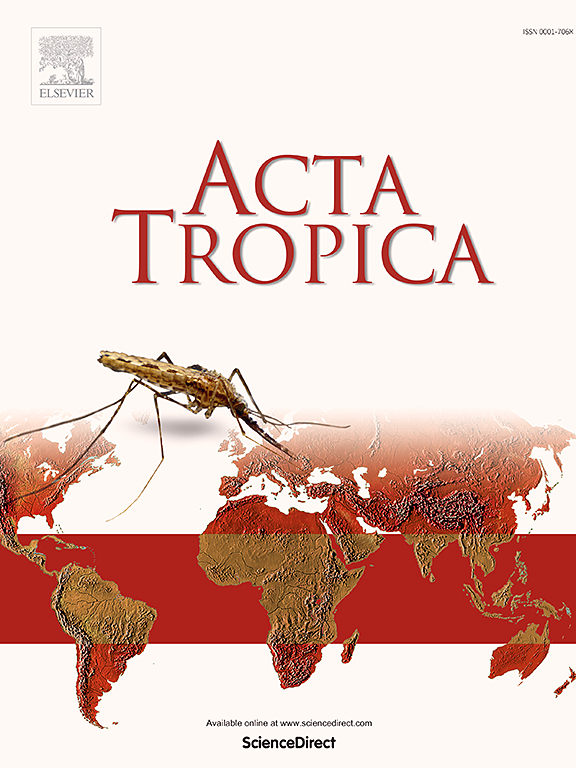Detection and isolation of Leishmania infantum and Leishmania tarentolae in sand flies from a canine leishmaniasis endemic area
IF 2.1
3区 医学
Q2 PARASITOLOGY
引用次数: 0
Abstract
Sand flies are blood feeding insects known as vectors of Leishmania spp. worldwide, with Leishmania infantum being the most relevant species in Southern Europe. The sympatric occurrence of L. infantum, which causes canine leishmaniasis (CanL), along with the reptile-associated Leishmania tarentolae, triggered the interest to investigate their transmission dynamics in sand fly vectors. Sand flies were collected over two consecutive years (2023–2024) in a CanL endemic area using CDC light traps and were morphologically identified. Female specimens were either screened for Leishmania spp. DNA by quantitative PCR (qPCR) or dissected alive for microscopic detection of flagellates. A total of 3477 sand flies (2076 males and 1401 females) were collected, and the most prevalent species were Sergentomyia minuta (n = 2379) and Phlebotomus perniciosus (n = 1020), followed by Phlebotomus neglectus (n = 44), Phlebotomus perfiliewi (n = 12), andPhlebotomus papatasi (n = 2). Promastigotes were observed microscopically in 13 S. minuta and one P. perniciosus, with L. infantum isolated from the latter. The qPCR analysis revealed that 50.0 % (n = 55/110) and 1.8 % (n = 2/110) of the S. minuta pools scored positive for L. tarentolae and L. infantum, respectively, whereas 25.0 % (n = 3/12) of P. perniciosus pools were positive for L. infantum. Among the individually tested engorged female sand flies, L. tarentolae and L. infantum were amplified from 35.8 % (n = 24/67) and 3.0 % (n = 2/67) of S. minuta, respectively, while 15.5 % (n = 9/58) of the Phlebotomus spp. (i.e., eight P. perniciosus and one Phlebotomus sp.) were positive for L. infantum. These findings confirm the co-circulation of L. infantum and L. tarentolae in sand flies, with a notably high detection rate of trypanosomatids in S. minuta through molecular and microscopic methods.

某犬利什曼病流行区沙蝇中幼利什曼原虫和链托利什曼原虫的检测与分离。
沙蝇是吸血昆虫,在世界范围内被称为利什曼原虫的媒介,其中幼利什曼原虫是南欧最相关的物种。引起犬利什曼病(CanL)的婴儿利什曼原虫(L. infant)和与爬行动物相关的链托利什曼原虫(Leishmania tarentolae)的同地发生,引发了研究它们在沙蝇媒介中的传播动态的兴趣。采用CDC灯诱法连续2年(2023-2024年)在某CanL流行区采集沙蝇并进行形态鉴定。用定量PCR (qPCR)筛选雌虫标本,或活体解剖,显微镜下检测鞭毛虫。总共有3477白蛉收集(2076男性和1401女性),和最普遍的物种Sergentomyia minuta (n = 2379)和Phlebotomus perniciosus (n = 1020),其次是Phlebotomus neglectus (n = 44),Phlebotomus perfiliewi (n = 12),Phlebotomus papatasi (n = 2)和Phlebotomus sp。(n = 20)。在13株min S.和1株perniciosus中显微镜下观察到原毛菌,从后者中分离到婴儿乳杆菌。qPCR分析结果显示,50 % (n = 55/110)和1.8% (n = 2/110)的minuta和P. minuta菌池分别检测到L. tarentolae和婴儿乳杆菌,25 % (n = 3/12)的perniciosus菌池检测到婴儿乳杆菌。在被单独检测的成年雌沙蝇中,携带利什曼原虫的比例分别为35.8% (n = 24/67)和3.0% (n = 2/67),携带幼利什曼原虫的比例分别为15.5% (n = 9/58),分别为8只白蛉和1只白蛉。这些结果证实了沙蝇中存在婴儿乳状虫和链托乳状虫的共循环,通过分子和显微镜方法对沙蝇中锥虫的检出率非常高。
本文章由计算机程序翻译,如有差异,请以英文原文为准。
求助全文
约1分钟内获得全文
求助全文
来源期刊

Acta tropica
医学-寄生虫学
CiteScore
5.40
自引率
11.10%
发文量
383
审稿时长
37 days
期刊介绍:
Acta Tropica, is an international journal on infectious diseases that covers public health sciences and biomedical research with particular emphasis on topics relevant to human and animal health in the tropics and the subtropics.
 求助内容:
求助内容: 应助结果提醒方式:
应助结果提醒方式:


